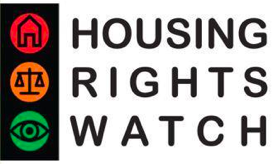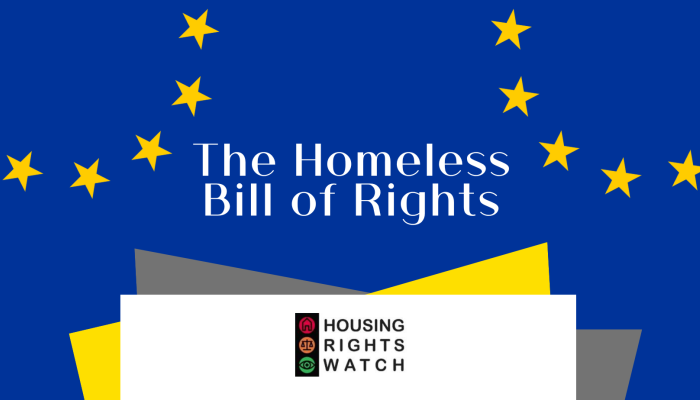Fondation Abbé Pierre and FEANTSA published their 8th annual Overview of Housing Exclusion in Europe. This report reveals new estimates of the number of homeless people in Europe and draw a specific focus to the issue of unfit housing.
The spectre of inflation
The war in the Ukraine has both highlighted and added to Europe’s ongoing housing emergency. This crisis is hitting the poorest households hardest, severely affected by soaring prices, as well as homelessness services, which have seen an increase in the number of their clients.
After two very difficult years, Europe then experienced inflation rates not seen for over twenty years. Energy and food prices were hit particularly hard. Energy prices rose sharply (25% in December 2022) as a result of the cutting off of Russian gas supplies to Europe. Food prices also saw an exceptional rise (14% in December 2022), as Ukraine and Russia accounted for almost 30% of international wheat exports. In all European countries, food and energy, along with housing, took up the bulk of the budgets of low-income households. Energy costs were a particularly egregious burden for low-income and casual workers, many of whom live in poorly insulated homes, making them vulnerable to soaring energy prices.
European governments took steps to cushion the blow of these cost increases and protect people, but many of these measures proved insufficient to prevent the most vulnerable from falling into or falling further into poverty. Most governments favoured non-targeted measures to influence prices over policies to boost incomes.
Welcoming Ukrainian refugees
Due to European legislation, EU Member States have, to various degrees, received the 4.5 million Ukrainian refugees in accordance with the rules around subsidiary protection (more than 1.4 million people were registered in Poland on 12 September 2022). While several issues have arisen through this unconditional reception of refugees, housing is unquestionably one of the major challenges. EU funds have been made available to help Member States accommodate these refugees in the best possible conditions, and governments have been able to find and subsidise private accommodation (such as hotels) on a massive scale. Despite this, governments have struggled to adequately stretch the existing housing supply. Furthermore, Member States have come up against completely different problems when looking for longer-term housing solutions for refugees.
In several European countries, specific financial assistance for hosting refugees has now been reduced to encourage them to integrate into the rental market. This transition towards renting apartments – both private and social – is putting pressure on an already oversubscribed market. Furthermore, difficulties in accessing housing can be exacerbated for refugees due to their lack of familiarity with the language and the local rental market, inadequate income, or the inability to produce the documents required by landlords. This is not to mention the discriminatory behaviour and negative bias against foreigners on the part of landlords at times.
895,000 homeless people in Europe
The context is worrying, but the situation is not new. At least 895,000 people are homeless in Europe. This estimate – based on patchy data and focusing only on the most visible forms of homelessness – highlights the failure of European countries to make housing a fundamental right: every night in Europe, a population comparable to that of a city like Marseille or Turin is homeless.
Unfortunately, the phenomenon is still increasing in the majority of Member States. In Germany, according to the first nationwide census conducted in 2022, 262,645 people are homeless; Spain recorded 28,552 homeless people that same year, 24% more than in 2012; 11,632 people were being cared for in emergency accommodation centres in Ireland at the end of December, the number of people requiring accommodation services has risen by 40% over the last two years. So far, only a few countries, like Finland, Denmark and Austria, are making demonstrable progress in reducing homelessness. Turning the tide will require unprecedented political efforts and bold structural measures.
Unsanitary, overcrowded and poorly insulated housing
The average quality of European housing has improved overall over recent decades. However, in 2023, millions of people will still be living in unfit conditions in Europe. Damp and mould, overcrowding, difficulty in maintaining an adequate temperature, exposure to pollution, inadequate sanitation, fire risk and structural defects remain a daily reality for many Europeans. Unfit housing is at the crossroads of a series of social, economic, and political issues. These include the increasing vulnerability of the poorest households, deregulation of the housing market and property speculation, inadequate public polices, unsuitable legal standards, and dilapidated or insufficient social housing stock, etc. Through lack of resources and low supply of social housing, part of the population, unable to pay high housing costs, find themselves stuck in a dilapidated rental sub-market or trapped in properties that are impossible to renovate.
Given the disparities between housing stock in different countries, both in terms of availability and of quality, unfit housing is very unequally distributed across Europe. In some countries, a significant proportion of the population lives in housing that does not meet average standards of habitability. In 2020, almost half the population (45%) of Romania were living in overcrowded housing, and more than one in eight Bulgarians (13%) were living in housing without an indoor toilet. Nonetheless, unfit housing is not the preserve of Eastern Europe. In 2020, almost a fifth of the population (18%) were living in housing that could be considered unfit in France, and almost a quarter of private rented housing (23%) was deemed unfit in the United Kingdom. It should be noted that unfit, cramped housing is not the preserve of rented units put on the market by unscrupulous landlords. Unfit living conditions also affect countless owner-occupiers who do not have the resources to maintain or renovate their home.
According to Eurostat, 4.3% of the total European population – more than 19.2 million people – were experiencing severe housing deprivation in 2020. This refers to the percentage of people living in overcrowded housing which has at least one of the following criteria: “households with a leaking roof, no bath / shower and no indoor toilet, or a dwelling considered too dark”. 10.2% of the European population were living below the poverty line and affected by severe housing deprivation. This figure demonstrates the correlation between economic instability and unfit housing. The Eurostat data also provide a more precise overview of the different dimensions of unfit housing. In 2020, 14.8% of European households (23.1% of households below the poverty line) were living in housing with leaks, damp foundations, or mould. 17.4% (29.2% of households below the poverty line) were living in overcrowded housing; and 7.5% (18.1% of households below the poverty line) were unable to maintain an adequate temperature in their home.
The high price of unfit housing
Unfit housing can have serious consequences for the lives of occupants and their immediate neighbours. The most dramatic examples are building collapses and similar disasters that lead to the death or injury. Two recent events that are imprinted on the collective European imagination are London’s Grenfell Tower fire of 2017, and the building collapse on Rue d’Aubagne, Marseilles in 2018.
These days, housing is recognised as one of the main social determinants of health. According to the World Health Organization, “inadequate housing is responsible for more than 100,000 deaths each year in the WHO European Region”. Damp and mould, widespread in European homes, can lead to respiratory infections, asthma, and allergies, but can also affect the immune system. Moreover, unfit or overcrowded housing can generate stress, anxiety, and depression.
Broadly speaking, unfit housing is a form of exclusion: inadequate housing conditions deprive occupants of social and economic opportunities. The lack of basic facilities, exposure to noise, lack of space, and overcrowding can impact integration into the workforce, academic results, and have consequences on children’s education. The problem also has a huge societal cost, not least because it generates endless medical expenses. Some years ago, Eurofound estimated the total annual cost on EU economies of keeping people in inadequate housing at close to EUR 194 billion, and that investment in the renovation required to definitively end the problem would be repaid within 18 months by savings in reduced healthcare costs and social outcomes.
Combatting unfit housing
In order to combat unfit housing effectively, the first step is to provide financial support to households. Social transfers are still, for the moment, the preferred tool for curbing the inequalities that foster inadequate housing. But demand-side policies should ideally be accompanied by an increase in supply. The fight against unfit housing can be leveraged to create new social housing or to develop an affordable private housing supply. While several local projects have demonstrated this, few projects have been carried out on a national scale. Ensuring that legal habitability standards are respected and ensuring the effective protection of tenants as set out by law is another way of tackling unfit housing. Tenants are by definition entering into unequal contractual relationships with their landlords. Tenants are not always aware of the legal procedures available, or prefer not to use them and so put up with indecent living conditions because they have no alternative, or for fear of worsening their already precarious situation.
To combat housing market abuses, regulatory measures can be established by the Member States. One of the tools available is facilitating investment in the construction of affordable housing. This means directing investment towards socially useful sectors even though they are less profitable. But regulating the housing market can also be in the form of simple rent controls. This type of regulation is particularly effective in guaranteeing access to low-rent homes. Studies have shown that rent controls are effective at protecting vulnerable tenants, by limiting price increases and the effects of evictions, when these neighbourhoods become more attractive.
The need to improve the quality of Europe’s housing stock is the subject of growing political attention in the context of the climate and energy crisis. Announced by Europe as part of its Green Deal, the “renovation wave” aimed at reducing carbon emissions must also provide an opportunity to tackle energy poverty and unfit housing. However, safeguards are required to protect households from increased housing costs: public subsidy and accompanying measures will have to be deployed to support poor homeowners and low-income tenants.
Recommendations
Deliver on the ambition of the European Platform on Combatting Homelessness
Launched in 2021 as part of the European Pillar of Social Rights, the European Platform on Combatting Homelessness (EPOCH) is the first-ever European policy initiative on homelessness. Member States, EU institutions and stakeholders have signed up to work together towards ending homelessness by 2030. This is a bold step on a social rights priority where EU competence is limited. The strategies initiated to improve data, release funding and promote mutual learning are promising signs. To go further and deliver on EPOCH’s ambition, FEANTSA and FAP recommend:
- All Member states should urgently design and implement national strategies to end homelessness.
- The European Commission should build on the achievements of the past three years and further develop EPOCH into a forum that supports concrete progress towards ending homelessness. This requires a new multiannual work programme to be adopted under the new Commission, a solid governance framework and a structural budget.
- All relevant EU policies should be mobilised to contribute to the goal of ending homelessness. This requires the development of inter-DG coordination as part of EPOCH.
Build a “Renovation Wave” to eliminate unfit housing
As part of the Green Deal, the European Commission has proposed an ambitious strategy for building renovation, including residential housing, known as the “Renovation Wave”. Legislation underpinning this is currently being negotiated. To address unfit housing, and avoid making housing even less affordable and accessible for lower income households, FEANTSA and FAP recommend:
- The pandemic highlighted the vital role of housing in debates around health. Combatting unfit housing is a public health imperative and should be a top priority in the design and implementation of the “Renovation Wave”.
- Adequate and targeted funding must be made available to deliver a socially just “Renovation Wave”. Indeed, energy efficient renovation and decarbonising heating and cooling of homes requires massive investment that low-income households will not be able to afford.
- Energy efficient renovation and the transition to green and affordable heating and cooling requires collaborative planning taking into consideration the specificities of the housing stock and the financial capacity of households.
- Social safeguards must be developed to ensure that the cost of the renovation wave does not drive housing exclusion. These include limits on rent increases, curbs on gentrification, and renovation focused on the needs of existing groups rather than on increasing property values.
- More work is required on the definition and mapping of unfit housing in Europe. An interpretive framework – applicable to all Member States – should be established on minimum habitability standards.
Read the full report in English and French here.
Read Chapter 3 on Minimum Decent Housing Standards In Europe




